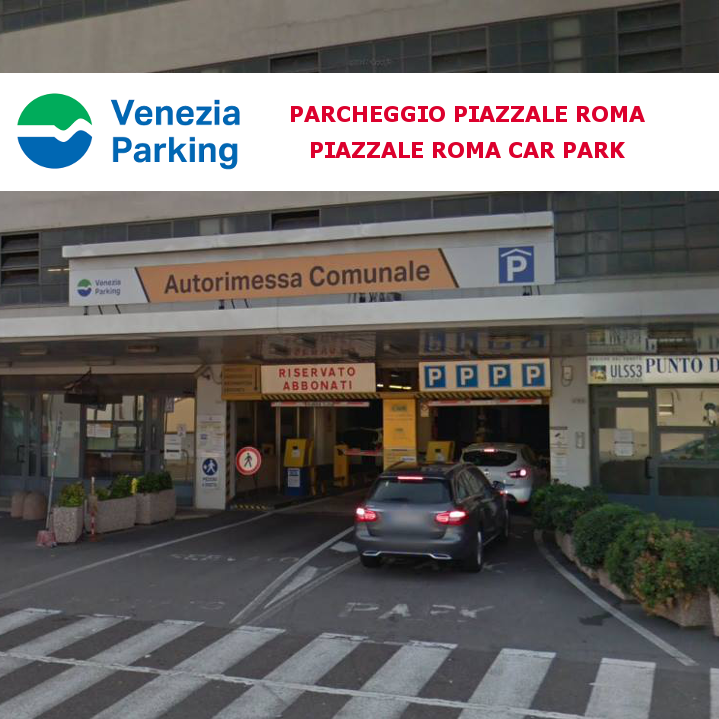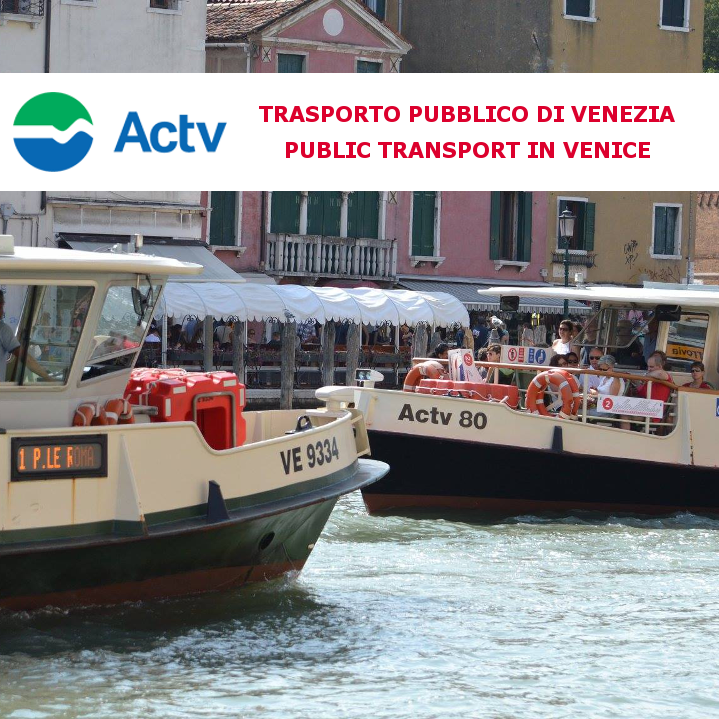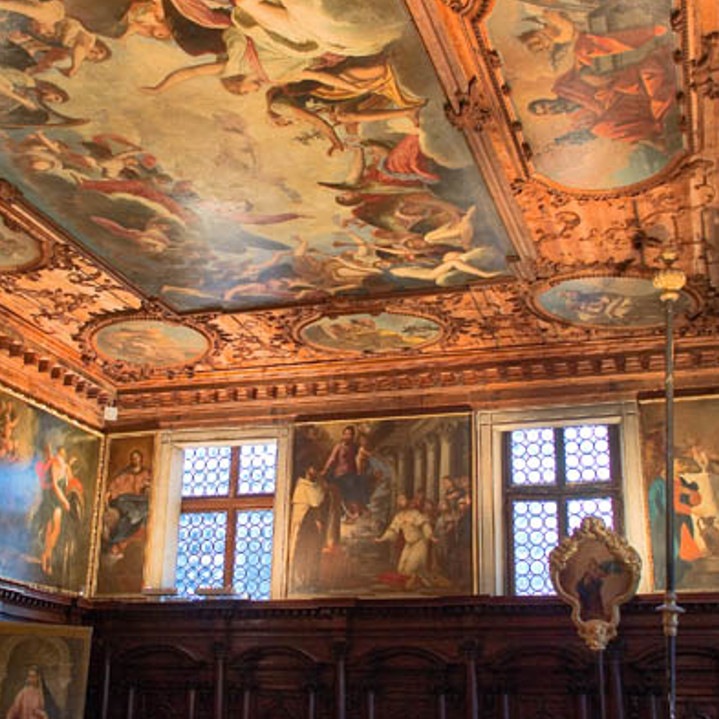You are here
The urban planning and the minor architecture of Venice
The urban planning and the minor architecture of Venice
This itinerary will explore some of the sights, churches and museums less frequented by tourists, with the aim of introducing and highlighting the more low-profile aspects of Venice.
It begins with a visit to the church and the Campo of San Stae overlooking the Grand Canal and the exterior of Ca' Pesaro, the most important baroque palace in the city, a masterpiece by Baldassarre Longhena. Today it houses the International Gallery of Modern Art which exhibits works of great artistic interest. The itinerary continues along "fondamente" and "calli" to explore some aspects of the so-called 'minor' or domestic architecture that better than any other will make us understand the true urban fabric of Venice and its construction techniques. Examples can be found in Campo Santa Maria Mater Domini where we will see authentic houses/warehouses still perfectly preserved. Then, after a break at the Museum of Perfume and Costume at Palazzo Mocenigo, we will move on to the area of San Giacomo dell ‘Orio with its fascinating church and a visit to the insula of San Boldo.
This itinerary suggests the discovery of three handicraft activities. The first, Mater Domini Mask, makes traditional Venetian masks, the second one, Ellemme Grafiche, is the heir of a glorious and old Venetian tradition, book printing, while the third one, Elisabetta Mason, follows in the footsteps of another very old tradition, carving wooden frames and gold plating them.
The Site “Venice and its Lagoon” has been inscribed on the World Heritage List since 1987 due to its Outstanding Universal Value, therefore it belongs to all of us: it is our common duty to respect it and preserve it so that it may be passed on to future generations.
The cultural heritage of the Site goes beyond the walls of palaces, churches, beyond islands and the lagoon, but is also memory, identity, community, all fundamental elements for the its vitality.
For this reason, in 2017 the City launched the #EnjoyRespectVenezia campaign with the aim of raising awareness of tourist impact among visitors and inviting them to maintain polite and correct behaviour during their stay, respecting the city and its inhabitants: it is important, for example, to walk keeping to the right, not to stop and sit on bridges, not to feed the pigeons, to observe a behaviour in keeping with the place you are visiting.
- Duration: approx. 5 hours including visits to the International Gallery of Modern Art (40 minutes) and the Museum of Perfume and Costume (30 minutes), while the itinerary as a stand-alone last about 3 hours and 50 minutes. The timeline is subject to change depending on the pace of the participants, their interests, the weather conditions and any unscheduled breaks
- Lenght: approx. 2 km
- Mode of travel: the itinerary takes place entirely on foot
- Recommended period: all year round. During the autumn months when high tides are more likely to occur, there are gangways to make the sights accessible
- Accessibility: not accessible to people with reduced mobility
- Departure: Campo San Stae
- Arrival: Campo San Boldo
- District: Santa Croce
-
Major attactions and highlights:
1. Chiesa di San Stae
2. Palazzo Pesaro now Galleria Internazionale d'Arte Moderna
3. Palazzo Mocenigo now Museo del Costume
4. Campo and Church of San Giacomo dall’Orio -
Squares and rest areas: there are no rest areas or facilities along this itinerary.
In Campo San Giacomo dell'Orio there are some benches where you can rest, always remembering that it is not possible to have a picnic, feed the pigeons and your behaviour must be appropriate to the places you are visiting, also in compliance with the rules of the #EnjoyRespectVenezia campaign - Pay Public toilet facilities: there are no public toilets along the itinerary
- Public drinking fountains: there are no public drinking fountains along the itinerary
- Venetian cuisine: On your way you could find traditional restaurants such as “osterie" and the "trattorie" serving genuine Venetian cuisine), such as appetizers made of various "cicchetti", pasta, "risi e bisi" (that is risotto with peas, or even a fish risotto, as well as delicious spaghetti with clams or spaghetti with squid ink all accompanied by a good glass of wine
Listen to the audio tour
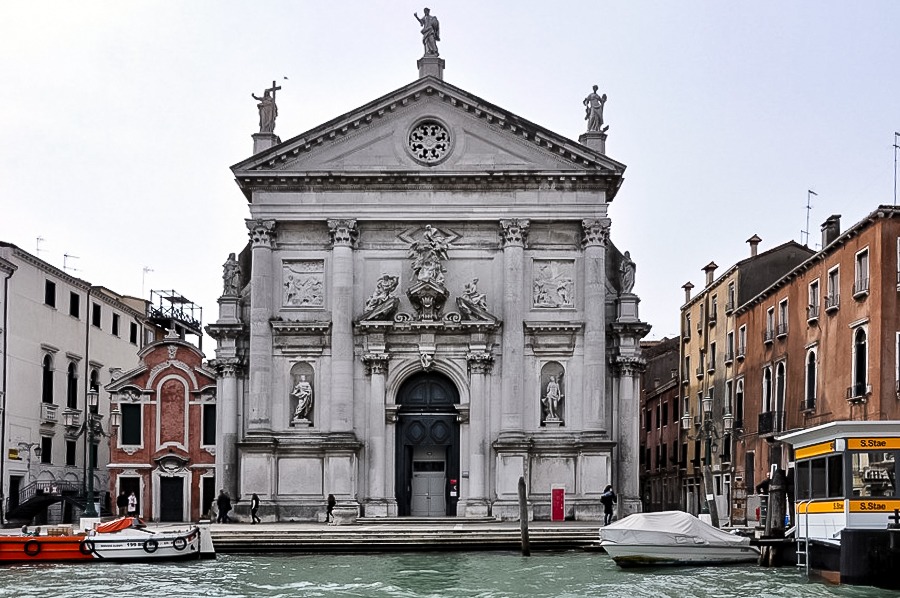
Chiesa di San Stae
ph. Comune di Venezia
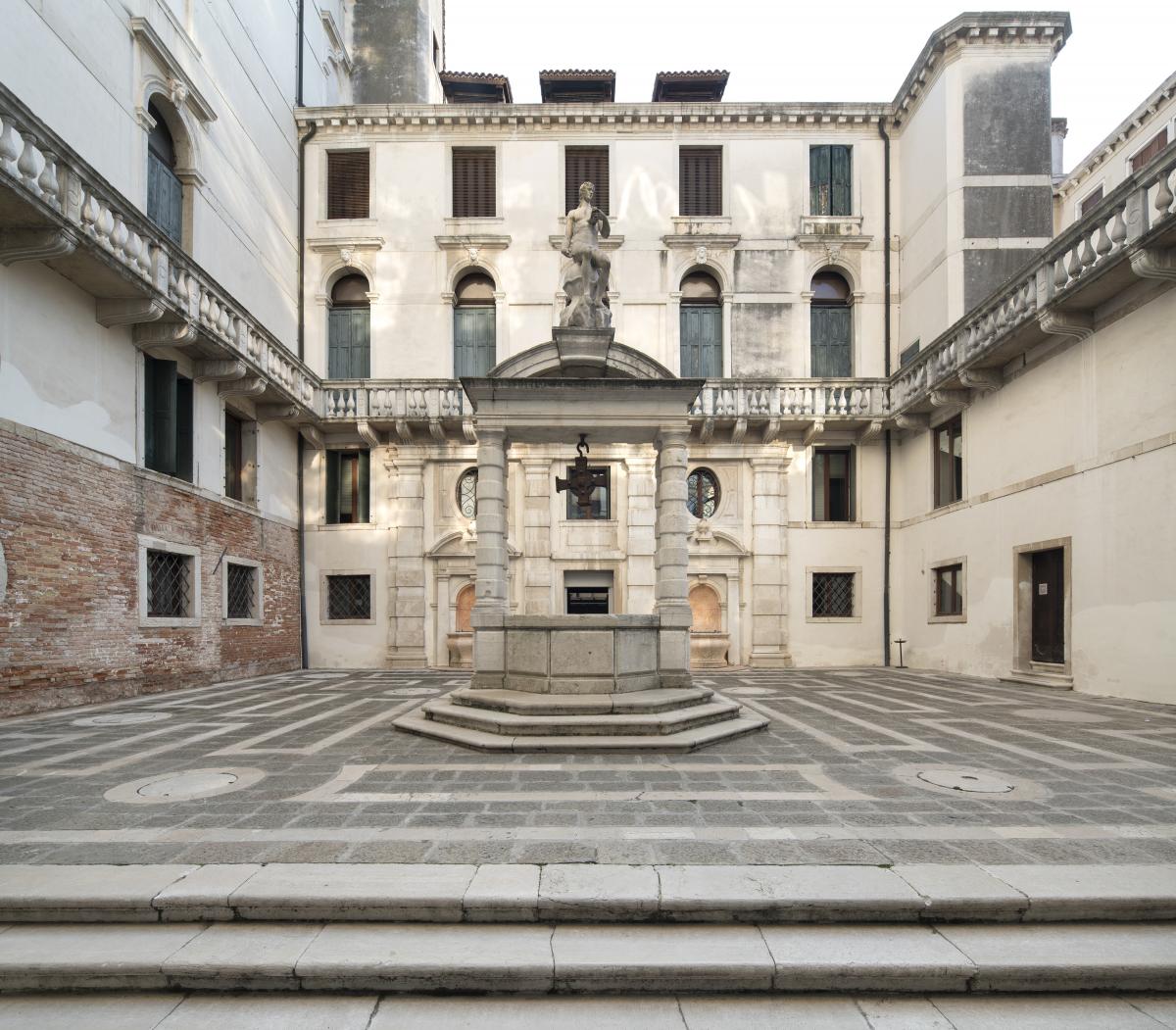
Courtyard of Ca' Pesaro
ph. Fondazione Musei Civici di Venezia
Stage 1: From Campo San Stae to Ca' Pesaro
The itinerary begins at the public waterbus stop of San Stae, which is the Venetian equivalent of St. Eustace.
From here you can admire the façade of the Church of San Stae, the only example in the city directly facing the Grand Canal, with its beautiful pediment above the entrance portal, surmounted by a group of floating angels providing a great dynamic effect and airiness, by one of the finest sculptors of the early 18th century. A peculiarity of this church is that it was entirely realized in a single stage, and for this reason it is absolutely stylistically consistent from the sculptural, architectural and pictorial point of view. The church was paid for by a legacy in the will of Doge Alvise Mocenigo, bequeathed in 1709. Mocenigo expressly wanted to remain anonymous, and, in fact, there is no trace of his name in any part of the facade or of the interior of the building. Also in this sense the church is really unique as in Venice a great number of the church facades were financed by private patrons with explicit self-celebratory intents. The interior is a veritable gallery of early 18th century pictorial and sculptural art, in particular the paintings that adorn the walls of the sanctuary decorated by the finest artists of the time. To name only a few, mention should be made of two masterpieces, the Martyrdom of St. Bartholomew by Gian Battista Tiepolo and the Martyrdom of St. James by Giovan Battista Piazzetta, who was his master. Master and pupil worked in strong stylistic consonance and the two works are both characterized by a strong contrast between light and shadow and by a style that almost makes it impossible to tell the two artists apart.
The small rococo building standing next to the church is the former Scoletta dei Tiraoro e Battioro (the gold thread makers and gold leaf beaters) characterized by delicate shades of pink and white. The stark contrast between the two buildings only serves to highlight the exuberant baroque style typical of Domenico Rossi, who designed and built San Stae in 1711, but also designed the monumental facade of the church of the Jesuits, chosen among the 12 projects submitted for the competition.
We proceed to Ca 'Pesaro and stop in the courtyard of the palace to admire its style and monumental grandeur. At the center of the courtyard is the original wellhead from the courtyard of the State Mint, now the reading room of the Marciana National Library.
Before starting the visit to the International Gallery of Modern Art, it is well worth mentioning that the Ca' Pesaro Years, the first avant-garde movement in Italy, were made possible by the bequest of Countess Felicita Bevilacqua La Masa at the beginning of the last century. In fact, the palace is famous for being the venue of the Ca' Pesaro exhibitions that were created as a counter-biennial in reaction to the too traditional and academic style that characterized the first exhibitions of the Art Biennale.
The museum houses Gustav Klimt's Salome', Chagall's Rabbi, a plaster model for Rodin's The Thinker and many other works by Mario Sironi, Gino Rossi and Arturo Martini, important exponents of the so-called Ca' Pesaro Years. Last but definitely not least, mention should be made of the American sculptor Alexander Calder, the founder of kinetic art, and Max Ernst, the surrealist who married Peggy Guggenheim.
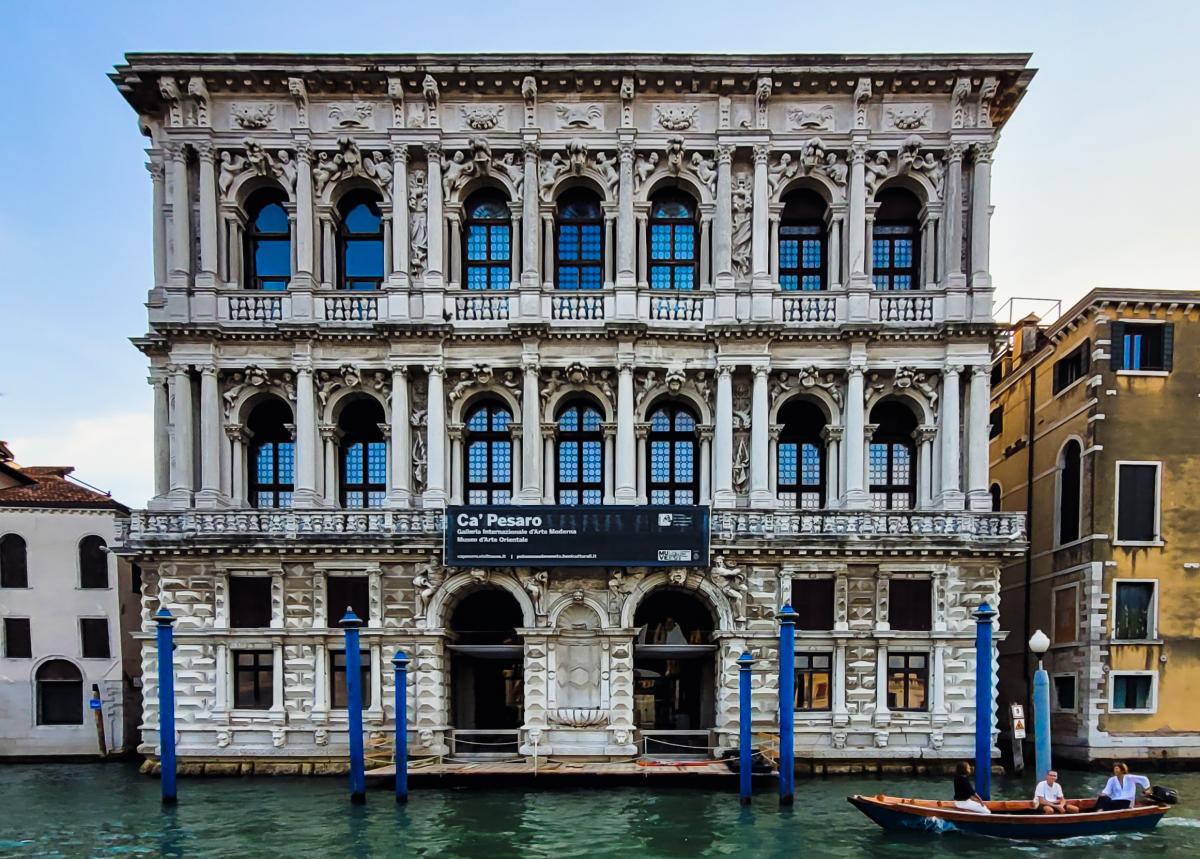
Ca' Pesaro
ph. Gabriele Vattolo - Comune di Venezia
Stage 2: From Ca' Pesaro to Campo Santa Maria Mater Domini
On leaving Ca' Pesaro, looking towards the end of the fondamenta, we can see Palazzo AgnusDio, so called because of the Mystic Lamb sculpted on the keystone of the main door and characterized by beautiful bas-reliefs on the four-mullioned window depicting the Annunciation and the Symbols of the Four Evangelists.
At the corner with Calle Tiozzi, we notice an interesting example of an ancient shop of the Gothic period with its large windows, formerly used to display the merchandise directly onto the street, with its beautiful beams decorated with the characteristic motif reminiscent of ship ropes.
The bridge at the end of Calle Tiozzi it the perfect vantage point from which to observe the impressive decoration by Antonio Gaspari on the side wall of Ca' Pesaro, which follows the natural course of the Rio della Pergola. This is a good opportunity to point out that the decoration of a palace was usually reserved for the facade, but this is not the case of Ca' Pesaro which is in fact the only example in the city with a very rich decoration in Istrian stone also on the side wall, which was instead generally made of simple rendered bricks.
We retrace our steps via Calle del Forno to Fondamenta Rimpeto Mocenigo to admire the imposing water facade of the homonymous palace, once the residence of the San Stae branch of this important family of the Venetian aristocracy. The House of Mocenigo had very ancient origins, and seven of its members served as Doges to the Serenissima. Noteworthy si the majesty of this late 17th century palace, especially if compared to the small-scale Fondamenta and the more modest buildings in the nearby Campiello dello Spezier. We will then walk across Campiello dello Spezier to reach Campo Santa Maria Mater Domini, past Ponte Cristo and Calle delle Chiesa.
In the square, time seems to have stopped and you can still breathe a medieval atmosphere. Not only does the architecture date back to a period between the thirteenth and fourteenth centuries, but also most of the shops and workshops, like the old printing house, the jeweler and the mask studio, are housed in the original buildings.
After the visit to the artisan studios, we will pause in the campo to view some fondaco houses, buildings combining a warehouse and the merchant’s private residence, and see how, through the centuries, styles may have changed but the structure of the typical merchant house remained unaltered. We will observe how the facade is tripartite with the central part marked by an airy mullioned window that corresponds to the internal Portego, a sort of show room of the time where goods were displayed and exchanges negotiated. The lateral parts have fewer windows and correspond to the living spaces. At one time they were also characterized by the so-called torreselle [the turrets still visible on the Fondaco dei Turchi which can be easily reached from Calle Larga arriving in Campo San Giacomo dall'Orio and then proceeding along the Fondamenta del Megio. The ground floor was used as a storehouse, while the mezzanine floor housed the offices and the small windows that can be seen in the attic floor correspond to the living quarters of the staff and servants.
The Campo offers a thirteenth-century example in Ca' Zane, characterized by the original projecting roof that was no longer built after 1291, when laws were passed to control fires in the city. Note, in fact, how the oldest part of the facade of Casa Zane still retains in its projecting roof in addition to the beautiful multi-light window, the round paterae and the thirteenth-century Venetian/Byzantine crosses, while the parts that were rebuilt at a later date no longer have the projecting roof.
Opposite Ca' Zane, there is another example of a fondaco house in fourteenth-century Gothic style with the same three-part division visible on the facade. At the end of the campo we have an interesting house of the same period and the same style but with the second floor polifora remodeled in the Renaissance period.
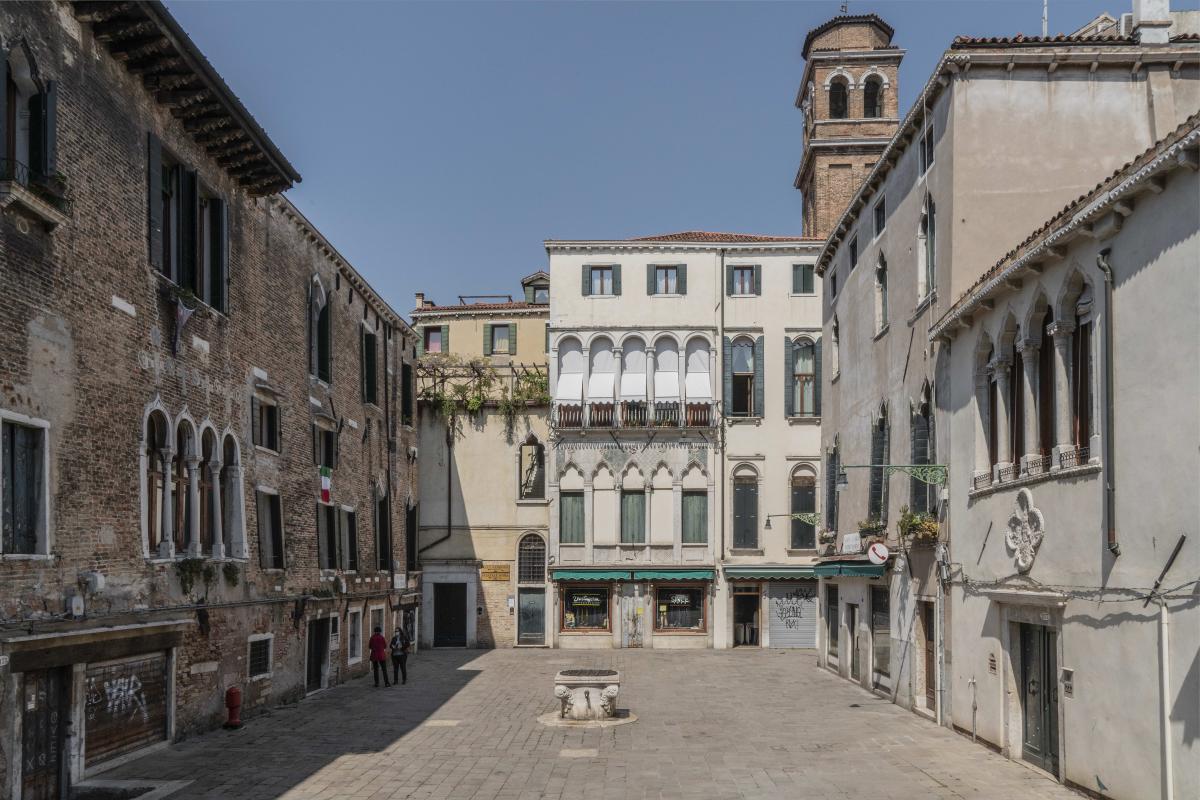
Campo Santa Maria Mater Domini
ph. Giorgio Bombieri - Comune di Venezia
Stage 3: From Campiello dello Spezier to the Elisabetta Mason's workshop
We turn back towards Campiello dello Spezier for a short stop at a local cicchetteria.
Past Ponte della Rioda we get to Salizada di San Stae and enter the spacious vestibule on the ground floor of the Palazzo, today restored and housing the Museo del Costume e del Profumo (Museum of Costume and Perfume), from where we can see the same water gate we observed on the opposite side of the Rio and admire the busts of the most famous members of the Mocenigo family.
It is definitely worth visiting this palace also to enjoy the authentic atmosphere created by the original furniture, the only example in Venice among the many palaces that have been converted into museums.
We then take Calle del Tintor and turn right into Calle del Forno for a stop at the studio of Elisabetta Mason, restorer of wooden furniture and gilder.
After visiting the studio, it is worth making a small detour at the end of Calle del Forno to admire the Venetian baroque portal that provides access to the garden and courtyard of Ca'Tron, which today houses the University Institute of Architecture.
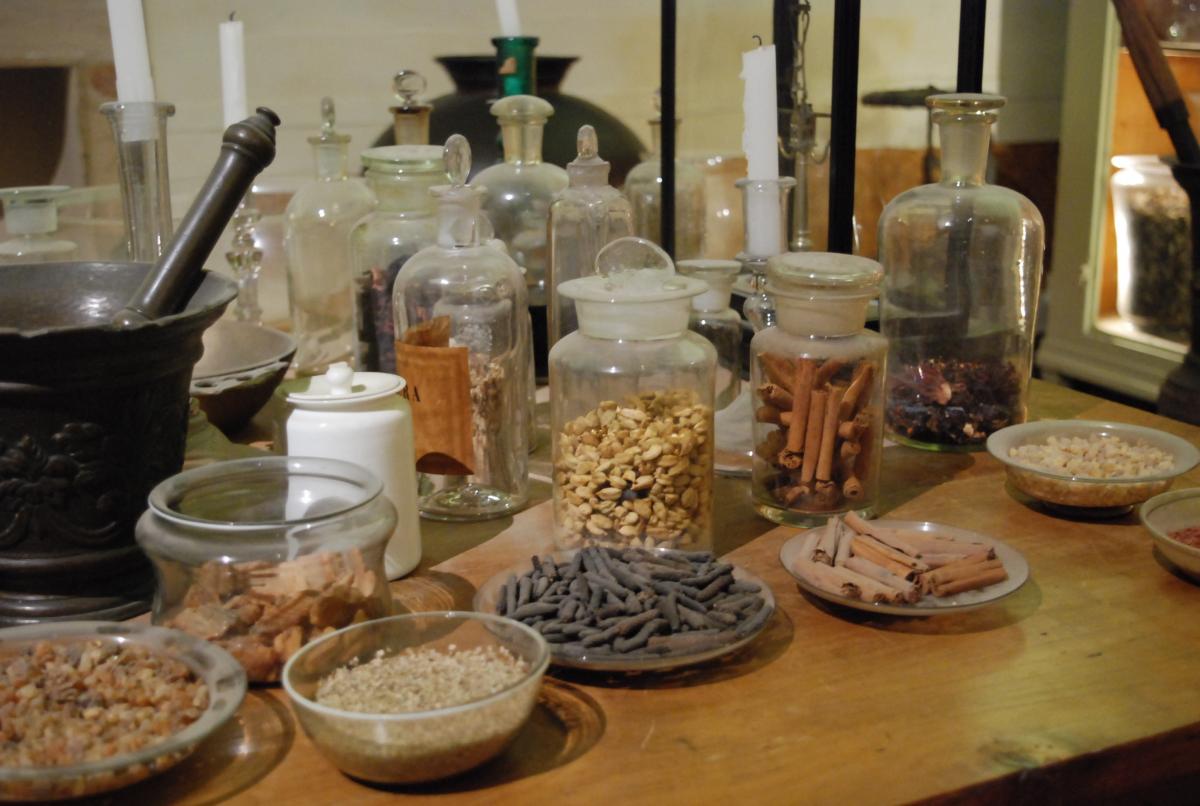
Museo del Profumo a Palazzo Mocenigo
ph. Renato Greco - Comune di Venezia
Stage 4: Campo and Church of San Giacomo dall'Orio
The fourth section of the itinerary begins by heading towards Campo San Giacomo dall'Orio for a well-deserved break sitting on the benches near the flowerbeds and trees opposite the Renaissance apses of the church of the same name. Here the local residents often sit to read and soak up the sun in the serene and relaxed atmosphere of the square.
When we take a closer look at the apses of the church of San Giacomo dall'Orio, we can see the imposing bulk of the Cappella del Santissimo with its high lantern dating back to the late 16th/early 17th century.
The visit to the church will be an unforgettable experience for the richness and variety of the historical stratifications inside, as well as for the numerous art highlights that the church guards in its interior and that can be better appreciated and understood with the help of an expert guide due to the depth of their meaning and their high historical/artistic value.
This is one of the oldest churches in Venice both in terms of the existing building, dating back to the thirteenth century, and in its spatial layout. The thick columns supporting the nave are still the original ones. The church also boasts a very rare fourteenth-century wooden ship's keel roof and a gem-like green marble column from the ancient Temple of Solomon in Jerusalem, brought to Venice as war spoils at the time of the Fourth Crusade. It was also admired and described by Italian poet Gabriele D'Annunzio in the early 1900s. As part of the Venetian plundering of the time, the church also acquired a baptismal font dating back to the seventh century and coming from Antioch.
Among the most notable paintings we have the Altarpiece of San Lorenzo by Paolo Veneziano, on the high altar, a rare work by Lorenzo Lotto dated 1546, a Cross painted by Paolo Veneziano dated 1324, two splendid late 16th century Cosmic Crosses and a 13th century Byzantine Madonna.
The Old Sacristy off of the left transept contains an exceptional pictorial cycle by Jacopo Palma the Younger dedicated to the theme of the Eucharist and its origins in the Jewish Passover (Easter).
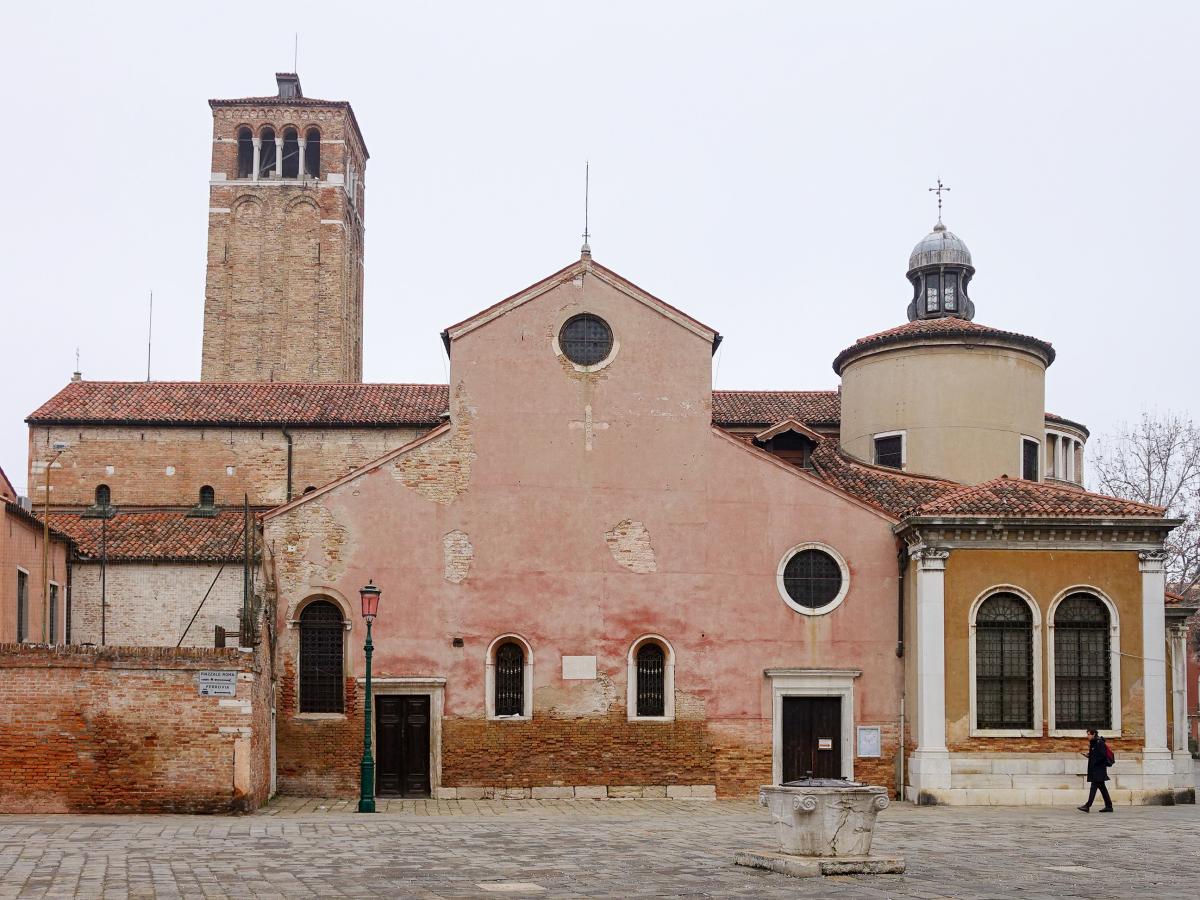
Church of San Giacomo dall'Orio
ph. Gabriele Vattolo - Comune di Venezia
Stage 5: From Campo San Giacomo dall'Orio to Campo San Boldo
Coming out of the church of San Giacomo dell'Orio it is worth noting that there is a canal-side facade, but if we go round the church, we can see another facade facing the campo on the opposite side of
the church. The dual facades, land and canal-side are a constant in Venetian architecture both for civil and religious buildings, in a city with a double circulation system, i.e., over land and water.
Exactly opposite the land-side facade of the church stands the old 16th century Anatomical Theatre, now converted into residential units.
We continue towards Calle del Tintor and turn left along the short Fondamenta del Parrucchetta to reach Ponte San Boldo, which is the Venetian for Saint Ubald, from the name of the church annexed to an ancient hospice for poor women founded in the 14th century. After the suppression and demolition of the church and the hospice of San Boldo, the remains of the ancient bell tower were incorporated into the Grimani palace built on the ground of the church and now a residential building.
This is a very atmospheric and mysterious place where some of the most dramatic scenes of Death in Venice were filmed. The director Luchino Visconti based the film on the famous novel by Thomas Mann, in a Venice hard hit by a cholera epidemic, when the feverish protagonist collapses on the steps of the well of Campo San Boldo.
It is recommended to go around behind the bell tower to observe the water facade of Palazzo Grimani from Ponte Storto.
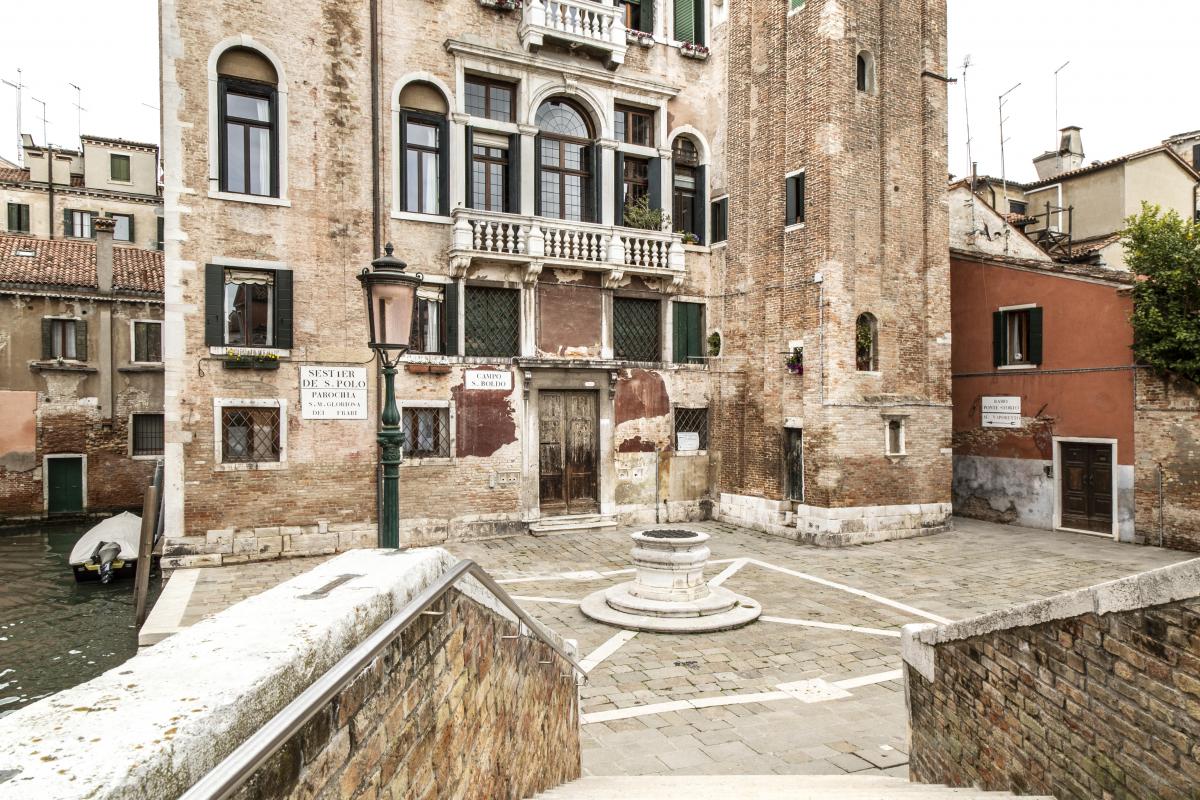
Campo San Boldo
ph. Giorgio Bombieri - Comune di Venezia



